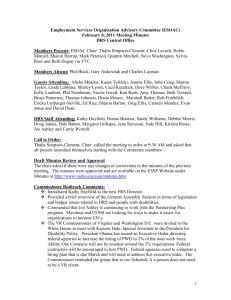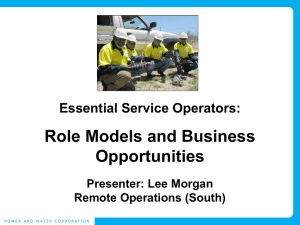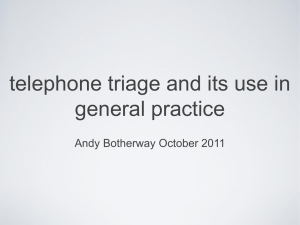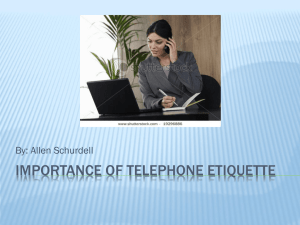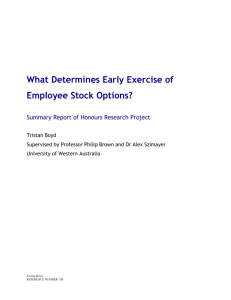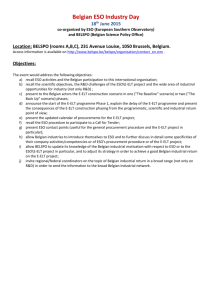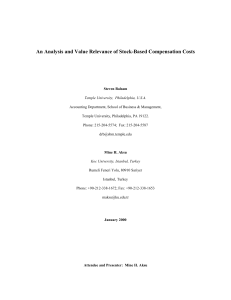Overview of Australian emergency call service1
advertisement
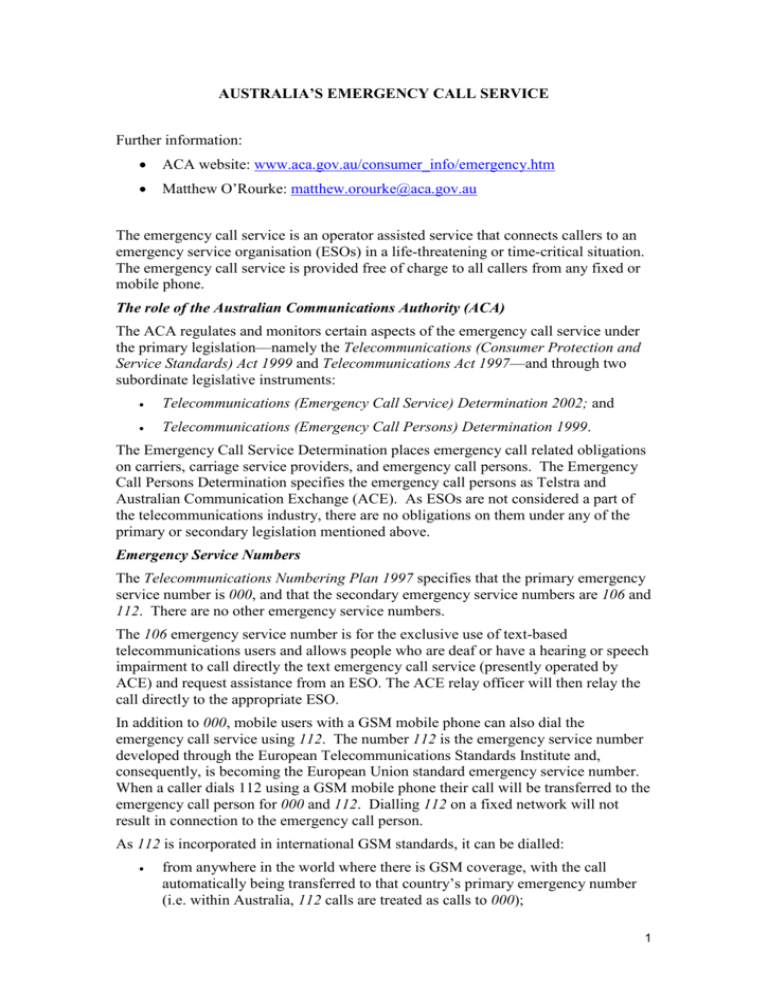
AUSTRALIA’S EMERGENCY CALL SERVICE Further information: ACA website: www.aca.gov.au/consumer_info/emergency.htm Matthew O’Rourke: matthew.orourke@aca.gov.au The emergency call service is an operator assisted service that connects callers to an emergency service organisation (ESOs) in a life-threatening or time-critical situation. The emergency call service is provided free of charge to all callers from any fixed or mobile phone. The role of the Australian Communications Authority (ACA) The ACA regulates and monitors certain aspects of the emergency call service under the primary legislation—namely the Telecommunications (Consumer Protection and Service Standards) Act 1999 and Telecommunications Act 1997—and through two subordinate legislative instruments: Telecommunications (Emergency Call Service) Determination 2002; and Telecommunications (Emergency Call Persons) Determination 1999. The Emergency Call Service Determination places emergency call related obligations on carriers, carriage service providers, and emergency call persons. The Emergency Call Persons Determination specifies the emergency call persons as Telstra and Australian Communication Exchange (ACE). As ESOs are not considered a part of the telecommunications industry, there are no obligations on them under any of the primary or secondary legislation mentioned above. Emergency Service Numbers The Telecommunications Numbering Plan 1997 specifies that the primary emergency service number is 000, and that the secondary emergency service numbers are 106 and 112. There are no other emergency service numbers. The 106 emergency service number is for the exclusive use of text-based telecommunications users and allows people who are deaf or have a hearing or speech impairment to call directly the text emergency call service (presently operated by ACE) and request assistance from an ESO. The ACE relay officer will then relay the call directly to the appropriate ESO. In addition to 000, mobile users with a GSM mobile phone can also dial the emergency call service using 112. The number 112 is the emergency service number developed through the European Telecommunications Standards Institute and, consequently, is becoming the European Union standard emergency service number. When a caller dials 112 using a GSM mobile phone their call will be transferred to the emergency call person for 000 and 112. Dialling 112 on a fixed network will not result in connection to the emergency call person. As 112 is incorporated in international GSM standards, it can be dialled: from anywhere in the world where there is GSM coverage, with the call automatically being transferred to that country’s primary emergency number (i.e. within Australia, 112 calls are treated as calls to 000); 1 in any area covered by GSM (for example, when you are out of your carrier’s GSM coverage area but in the GSM coverage area of another carrier, your 112 call will be carried on that other carrier’s network); without necessarily having to key in a security-protection PIN; and without a SIM necessarily in the handset. Efforts are also being made in Australia to provide similar access capabilities for 000. Although access to 112 is only mandatory for GSM mobile phones, both of the CDMA networks in Australia can originate calls to 112. 112 cannot be dialled from the fixed network. Emergency Call Person The emergency call person is responsible for receiving calls made to the emergency service numbers and, if appropriate, transferring the calls to the appropriate ESO. Telstra is the emergency call person for calls to 000 and 112. ACE is the emergency call person for calls to 106. The role of the emergency call person is to connect callers to the nearest and most appropriate ESO as quickly as possible. The emergency call person for calls to 106 also relays the call to the appropriate ESO. Thus, the emergency call person is essentially a call centre which acts as an important national stepping stone to those that are responsible for providing the real help in an emergency situation—the ESOs. Emergency Service Organisations An ESO refers only to a police force, a fire brigade, or an ambulance service (or a service for dispatching a police, fire or ambulance service). No other organisation can be accessed through the emergency call service. ESOs come under the jurisdiction of the individual states & territories. Within a state or territory, ESOs may be managed under a single State Government Department or under a number of Departments. For example, in Victoria, all the ESOs are the responsibility of the Department of Justice. By contrast, in New South Wales the responsibility for the various ESOs is spread across the Department of Police, Department of Emergency Services, and the Department of Health. ESOs—particularly ambulance services—may also be operated by independent organisations, such as St John Ambulance Australia in Western Australia and the Northern Territory; and SA Ambulance Service in South Australia. Though even if operated by an independent organisation, they are still responsible to the relevant state government. Use of mobile location information All calls to 000 or 112 are routed with priority to one of two Telstra emergency service answering points where they are typically answered within five seconds. Calls to 106 are routed with priority to one of the two answering points operated by ACE where they are typically answered within one second. The computer systems used by the emergency call persons use the calling line identification (CLI) data that is provided with all emergency calls to interrogate a special emergency call service database called ECLIPS, which mirrors the content of the Integrated Public Number 2 Database (IPND). The IPND contains the subscriber details (i.e. name and address) associated with the phone number from which the emergency call has been made.1 For the majority of fixed line callers, the information obtained from ECLIPS is sufficient to determine in which ESO's jurisdiction the caller is in. Once the caller advises which emergency service is required, the emergency call person uses the caller’s postcode to determine the closest ESO answering point. The emergency call person will then transfer the call—together with the CLI data, subscriber details, and (for administrative purposes) a job number—to the appropriate ESO answering point. Once the ESO answering point begins talking directly with the caller, the emergency call person will disconnect itself from the conversation and prepare to answer another emergency call. The entire process up to this point, outlined in Figure A1 below, is so quick that the caller will usually not even realise that it has occurred at all. The process for emergency calls to 106 is slightly different as it involves the emergency call person facilitating the call by relaying the conversation between the caller and the ESO until the completion of the call. An additional step is involved in jurisdiction determination for calls made to the emergency call service from mobile phones. The CLI data will only indicate the subscriber’s billing address which cannot be used to determine the ESO answering point that is nearest to the caller at the time of the call. Accordingly, the originating mobile carrier will append a three-digit location indicator (LI) code to the digits/data 1 The IPND is a is an industry-wide database of all listed and unlisted public telephone numbers. It is managed by Telstra under the Carrier Licence Conditions (Telstra Corporation Limited) Declaration 1997. The IPND is a repository of public number customer data which, broadly speaking, includes a public number and associated information such as the customer’s name and address, the name of the service provider providing the carriage service, and whether the number is for business, government or residential use. This data may only be accessed and used for the approved purposes specified in clause 10(1) of the Carrier Licence Conditions (Telstra Corporation Limited) Declaration 1997. 3 string that it routes to the emergency call person. The LI code corresponds to a standardised mobile service area (SMSA), which represents a grouping of mobile cells that broadly reflects the mobile coverage areas of all mobile carriers combined. The diagram below shows this call process. Prior to the adoption of the SMSA-level of MOLI, the identification of the state or territory in which the call originated had overcome the problems caused by different locations sharing the same name. The emergency call person manually enters the LI code into a database of SMSA localities to bring up an alphabetical listing of the towns or suburbs corresponding to that SMSA. This information, of itself, is still not sufficient for the purposes of jurisdiction determination as an SMSA can range in area from approximately 2,000 to 500,000 square kilometres. By way of example, the LI code 211 corresponds to the Bendigo, Victoria SMSA which, in addition to the city of Bendigo, also comprises the ‘adjoining zones’ of Bridgewater, Goornong, Harcourt, Maldon, Marong, Raywood, Strathfieldsaye, Castlemaine and Rushworth. An emergency caller displaying the LI code ‘221’ could be anywhere in any one of these towns. To further narrow the caller’s likely location the emergency call person will verbally query the caller about his or her location until enough environmental information is obtained to allow the emergency call person to determine the ESO answering point that is nearest the caller. Having done so, the emergency call person then routes the call to the appropriate ESO answering point. 4

